Throw Yourself in Next Time (2U71)
Back to Mines of Moria Index |
Troubled Mountains (2U72) |
Throw Yourself in Next Time (2U71) is a Moria Condition from the Mines of Moria set.
| ||||||||||||||||||
| ||||||||||||||||||
| ||||||||||||||||||
Strategy
Gameplay Strategy
This card is often overlooked by Moria players for its situational bent, unplayable against a Free Peoples without a Hobbit and useless against a Free Peoples that won't be exerting its Hobbits anyway. But until Movie Block every deck is required to have at least one Hobbit (Frodo), and in Fellowship block every deck is likely to have at least one card that will exert a hobbit: Sting (1R313)
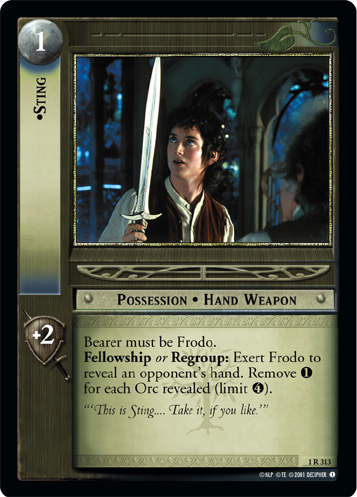 . Add in the popularity of Merry, Friend to Sam (1R302)
. Add in the popularity of Merry, Friend to Sam (1R302)
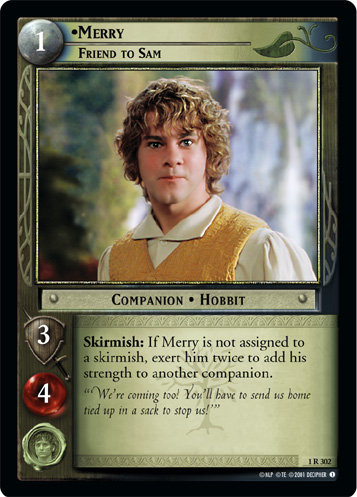 and Sam, Son of Hamfast (1C311)
and Sam, Son of Hamfast (1C311)
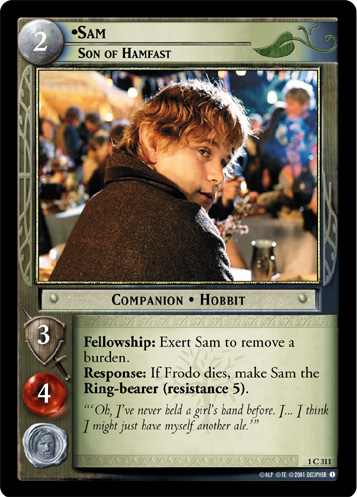 , plus the powerful effects of Filibert Bolger, Wily Rascal (2C101)
, plus the powerful effects of Filibert Bolger, Wily Rascal (2C101)
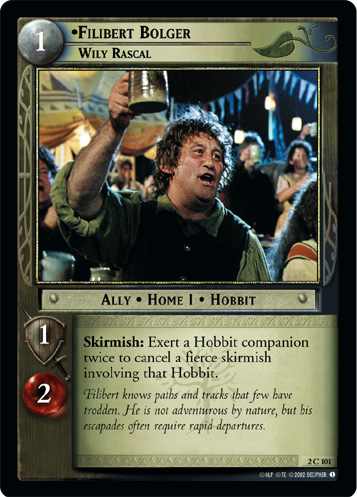 and Frying Pan (3C108)
and Frying Pan (3C108)
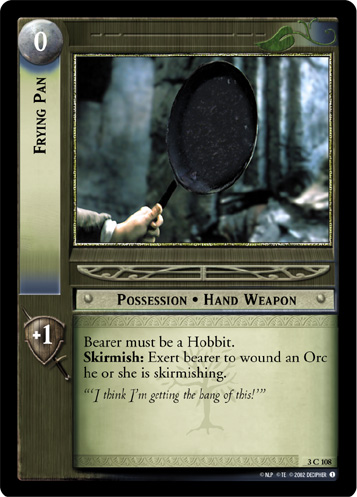 , and there's no shortage of opportunities for this card to interfere with a Fellowship.
, and there's no shortage of opportunities for this card to interfere with a Fellowship.
Playing it on Frodo is always a safe bet, as Sting or Frying Pan will probably be put on him at some point even if he doesn't have them now. Merry, Friend to Sam is also an obvious target when he is in play, though it may not be worth playing on him once his text has been used already and is rarely worth holding in hand for him. Sam, Son of Hamfast is rarely any concern, but Sam, Proper Poet (2C114)
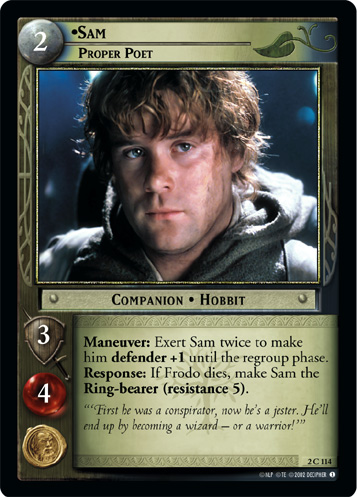 can cause problems for a swarm -- if Frodo is healthy, he can be sacrificed to keep the last minion off Frodo. And of course, if Frodo is too thin and stretched any version of Sam can bear Frying Pan and take The Ring. Perhaps ironically (given the movie scene referenced), Pippin tends not to have any innate use for his vitality and is often the least important companion to target. Still, his vitality can be an excellent resource for Frying Pan and Filibert Bolger, and preventing the Free Peoples from using it can get him killed a turn or two sooner than planned.
can cause problems for a swarm -- if Frodo is healthy, he can be sacrificed to keep the last minion off Frodo. And of course, if Frodo is too thin and stretched any version of Sam can bear Frying Pan and take The Ring. Perhaps ironically (given the movie scene referenced), Pippin tends not to have any innate use for his vitality and is often the least important companion to target. Still, his vitality can be an excellent resource for Frying Pan and Filibert Bolger, and preventing the Free Peoples from using it can get him killed a turn or two sooner than planned.
Beatdown decks typically have more supporting cards than swarms and can feel the impact of some of those Shire cards more. A deck with a great focus on the most expensive minions might not be able to afford losing twilight to Sting every turn, and pays much more dearly when a minion is killed by Frying Pan. A build oriented around Cave Troll of Moria, Scourge of the Black Pit (1R165)
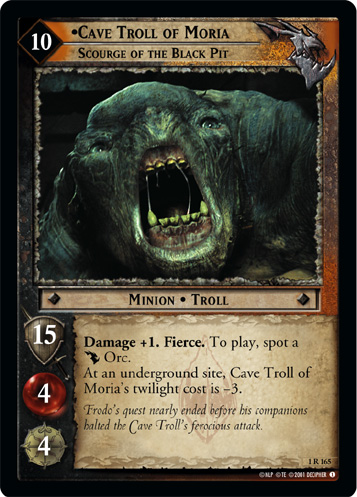 will also benefit greatly from nullifying Filibert Bolger.
will also benefit greatly from nullifying Filibert Bolger.
Swarm decks are not as forgiving in their deck compositions, and on top of that this card has a bit of a timing issue. Drawing it early might mean playing it before an opponent has any cards which exert Hobbits and drawing it late often means playing it after Hobbits are already nearly exhausted. In both cases, a minion would probably go much farther since swarms rarely build on themselves from one turn to the next. Instead, a typical build will simply throw as many minions as possible as often as possible at a Fellowship to use up its companions, either by killing them or getting rid of whatever keeps them alive (e.g., vitality for Frying Pan). This leaves just a small window of opportunity for it to bring any tangible benefit to the deck.
Archery decks have no use for it, since it cannot play on allies and disrupt healing. A dedicated corruption deck has use for this card, though not in an obvious way. Sam, Son of Hamfast will do most of his damage when played, and trying to keep him from being able to heal and remove more burdens causes a timing issue similar to what plagues the card in swarm decks. Instead, by playing it on the Ring-bearer you can prevent a Free Peoples from exhausting their own Frodo once they realize what's happening. This is particularly true in Movie Block and beyond, where Gollum, Dark as Darkness (9R+28)
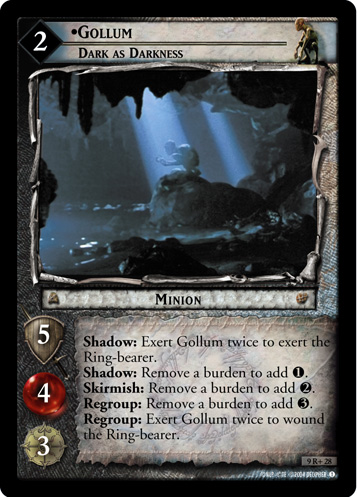 will be able to exert Frodo and Lost to the Goblins (1R189)
will be able to exert Frodo and Lost to the Goblins (1R189)
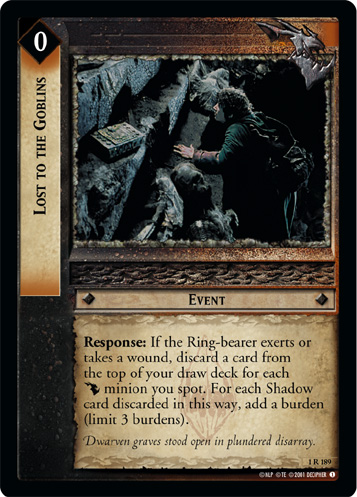 - after the deck has been stacked by Goblin Sneak (1U181)
- after the deck has been stacked by Goblin Sneak (1U181)
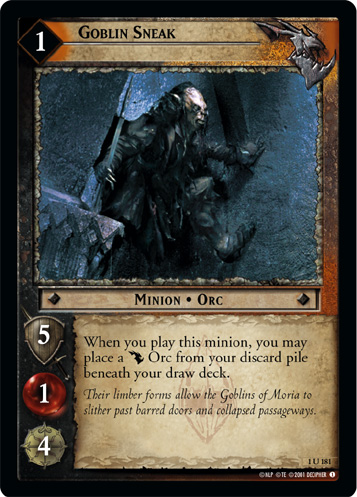 - reveals shadow cards to corrupt Frodo all at once. Host of Moria, Legion of the Underdeeps (9R+41)
- reveals shadow cards to corrupt Frodo all at once. Host of Moria, Legion of the Underdeeps (9R+41)
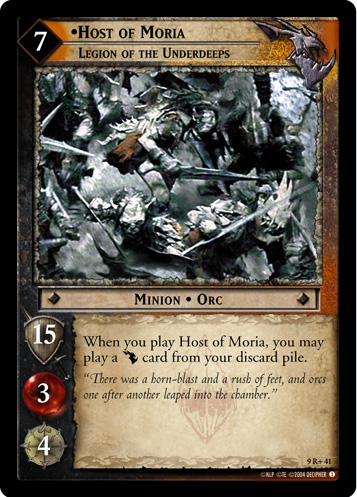 is able to play Throw Yourself in Next Time from discard, which can make the condition difficult to permanently remove.
is able to play Throw Yourself in Next Time from discard, which can make the condition difficult to permanently remove.
Unfortunately for this card, the reliability of seeing cards which are impacted by it drops dramatically later formats. Sting and Filibert Bolger were banned soon after the start of Towers Standard, while Frying Pan is banned beginning in King Standard and Sam, Son of Hamfast is banned from Expanded. There are other cards that exert Hobbits, of course, but none of them are usable in any deck the way those cards were. At the same time, the number of possible companions exploded: there are 16 distinct companions in all of Fellowship block and 30 in set 4 alone. This combination of a wider variety for Fellowships and fewer key cards available which exert Hobbits make it less generally useful as more cards are added, where Moria is already relatively weaker since it gets only a handful of new cards itself.
That said, it isn't outright useless. An unexpected use for the card in later formats is against Rohan: Merry's Sword (7R242)
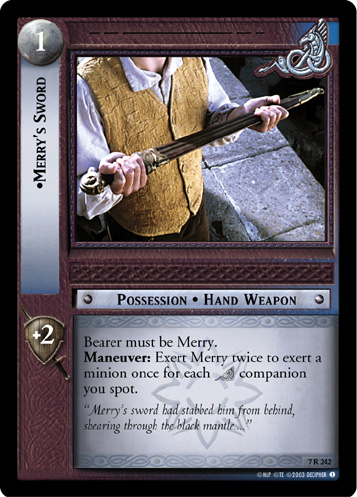 protects the fellowship from a variety of effects, most famously the wounds from Shotgun Enquea
protects the fellowship from a variety of effects, most famously the wounds from Shotgun Enquea
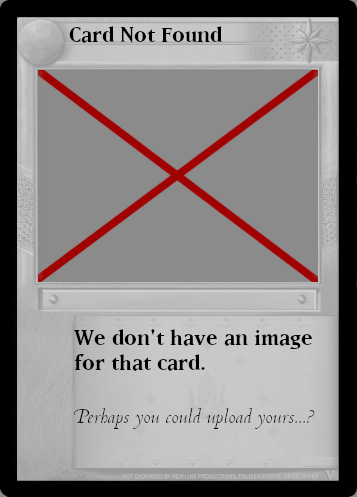 which is often included for crowd control in Moria decks since the culture lacks any of its own. Because Merry, Swordthain (7R321)
which is often included for crowd control in Moria decks since the culture lacks any of its own. Because Merry, Swordthain (7R321)
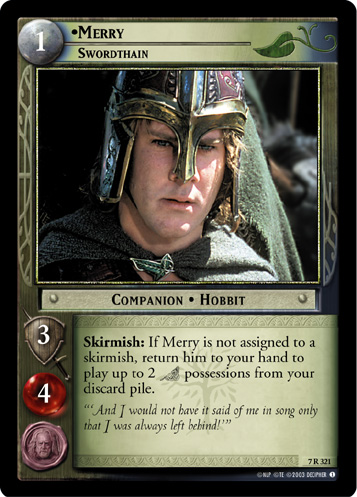 is the popular choice and he loses all stacked cards when returning to the Free Peoples Player's hand, the Shadow player may only be able to expect one turn of disruption per copy.
is the popular choice and he loses all stacked cards when returning to the Free Peoples Player's hand, the Shadow player may only be able to expect one turn of disruption per copy.
If it is needed, note that there is no restriction on the number of copies that can be played on a single companion. If there's only one Hobbit companion to play it on (or worth playing it on), extra copies can just stack on that character. The redundancy can save the effect from Athelas (1U94)
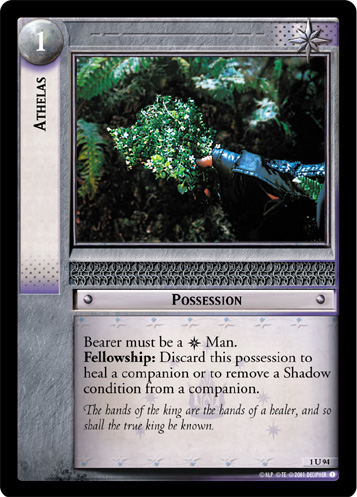 or offer padding against Secret Sentinels (2R20)
or offer padding against Secret Sentinels (2R20)
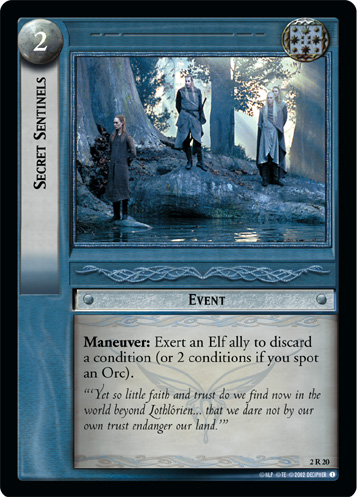 . As with all Shadow cards which play on a companion, this can tip a companion from 2 cards to 3 and allow Gríma, Wormtongue (4R154)
. As with all Shadow cards which play on a companion, this can tip a companion from 2 cards to 3 and allow Gríma, Wormtongue (4R154)
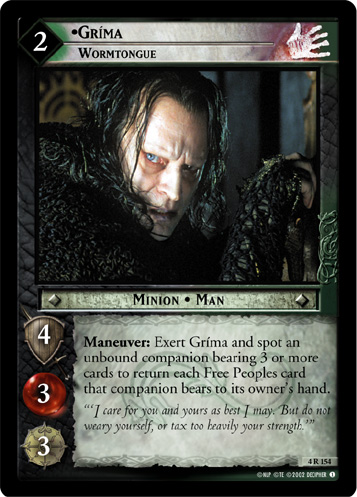 to send the Free Peoples cards back into its owner's hand. Sometimes this can be used to kill a Hobbit outright, if that companion's vitality is boosted by Escape (4R300)
to send the Free Peoples cards back into its owner's hand. Sometimes this can be used to kill a Hobbit outright, if that companion's vitality is boosted by Escape (4R300)
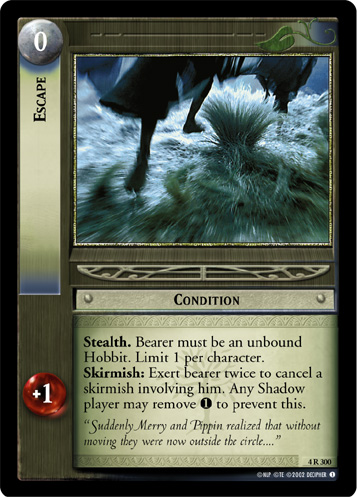 or Rare Good Ballast (5U114)
or Rare Good Ballast (5U114)
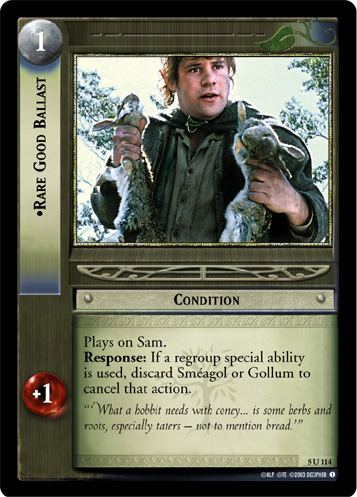 .
.
It is worth emphasizing that bearer may be exerted only by Shadow cards, which excludes more than just Free Peoples cards and can cut both ways. Frodo bearing this card at Moria Lake (1C346)
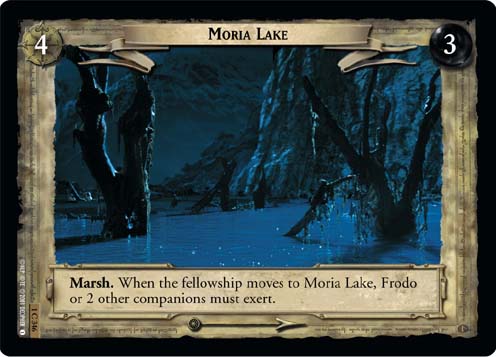 would force two other companions to be exerted instead, but he would likewise be exempt from Silverlode Banks (1U355)
would force two other companions to be exerted instead, but he would likewise be exempt from Silverlode Banks (1U355)
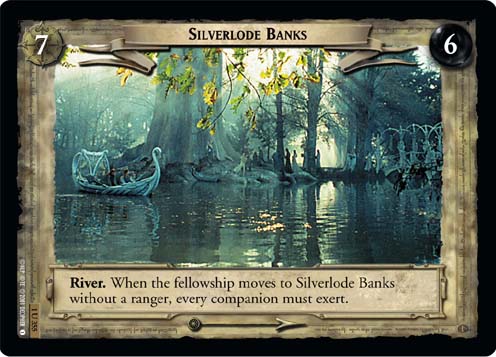 when moving there with no ranger. A Hobbit Ring-bearer with The One Ring, The Binding Ring (9R+1)
when moving there with no ranger. A Hobbit Ring-bearer with The One Ring, The Binding Ring (9R+1)
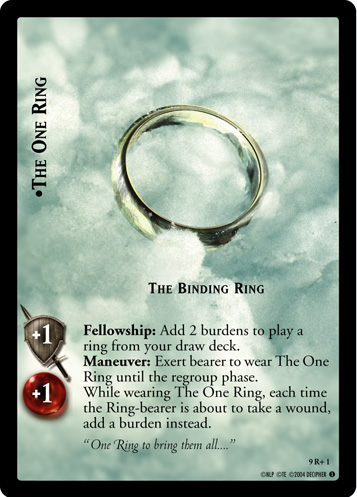 would not be able to wear it using its text.
would not be able to wear it using its text.
Deckbuilding Strategy
While Throw Yourself in Next Time is a straightforward solution to many problems, the question is whether those problems are actually worth solving -- whether using another card would have a greater benefit anyway. Sting (1R313)
 can remove 4 twilight, but there's no better culture for adding twilight back than Moria. Merry, Friend to Sam (1R302)
can remove 4 twilight, but there's no better culture for adding twilight back than Moria. Merry, Friend to Sam (1R302)
 can save someone from the swarm, but having another Orc in a swarm would probably have killed Merry anyway. The culture is rarely concerned with burdens and Sam, Son of Hamfast (1C311)
can save someone from the swarm, but having another Orc in a swarm would probably have killed Merry anyway. The culture is rarely concerned with burdens and Sam, Son of Hamfast (1C311)
 does his greatest damage the same Fellowship phase he was played. Filibert Bolger, Wily Rascal (2C101)
does his greatest damage the same Fellowship phase he was played. Filibert Bolger, Wily Rascal (2C101)
 and Frying Pan (3C108)
and Frying Pan (3C108)
 can be big hurdles, but they tend to only be seen in a deck with a big investment in the Shire culture which means weaker companions and less condition discarding.
can be big hurdles, but they tend to only be seen in a deck with a big investment in the Shire culture which means weaker companions and less condition discarding.
Beatdown decks have more room for non-minions and more to lose from the effects of these Shire cards, making the card a more natural fit there than in swarm decks. Regardless of what kind of deck you have, ask yourself what problem you want it to solve and whether it can be solved in another, more general way before turning to this card for answers.
After Fellowship block, when the most problematic cards are no longer available (or simply less effective), it becomes a definite meta call. There are some Hobbit exertions worth worrying about, sure, but if they're not seen very often it's probably not worth the card slot. Should you decide to run this card, 1 copy will often come too late, and after whatever damage you'd want to avoid has already been done. Given Moria's natural penchant for cycling you'll probably want more copies (discarding copies that come too soon, if applicable), yet given the very specific nature of the card you probably won't want too many. 2 copies is a good start to balance these two competing desires, and will give you a chance to see if the card has the impact you're hoping for.
Strengths and Weaknesses
Synergizes With...
- Host of Moria, Legion of the Underdeeps (9R+41)
 , to replay it when its intended target his the table
, to replay it when its intended target his the table - Gríma, Wormtongue (4R154)
 , when it pushes a companion from the normally safe 2 cards up to 3
, when it pushes a companion from the normally safe 2 cards up to 3 - Lost to the Goblins (1R189)
 , and especially Gollum, Dark as Darkness (9R+28)
, and especially Gollum, Dark as Darkness (9R+28)
 , to help keep the Ring-bearer from being exhausted until you are ready
, to help keep the Ring-bearer from being exhausted until you are ready - Moria Lake (1C346)
 , which will force the Free Peoples to exert two other companions when played on Frodo
, which will force the Free Peoples to exert two other companions when played on Frodo
Strong Versus...
- Sting (1R313)

- Merry, Friend to Sam (1R302)

- Sam, Proper Poet (2C114)

- Frying Pan (3C108)
 and Filibert Bolger, Wily Rascal (2C101)
and Filibert Bolger, Wily Rascal (2C101)
 , especially when Frodo is the only Hobbit
, especially when Frodo is the only Hobbit - Merry's Sword (7R242)

- Bilbo, Melancholy Hobbit (12R119)
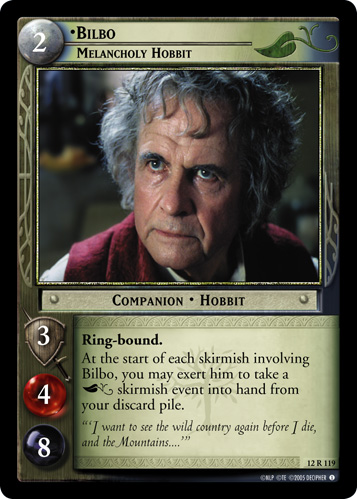
- The One Ring, The Binding Ring (9R+1)
 on a Hobbit Ring-bearer
on a Hobbit Ring-bearer - Aragorn, Elessar Telcontar (10R25)
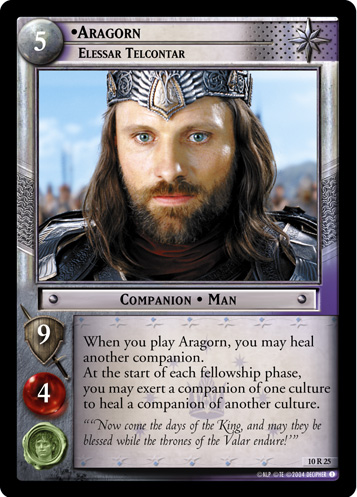 , who typically moves vitality from Frodo to other companions
, who typically moves vitality from Frodo to other companions
Weak Versus...
- Decks with no ways to exert Hobbits, especially those with an Alternate Ring-bearer where it is usually outright unplayable
- Merry, Swordthain (7R321)
 and Pippin, Wearer of Black and Silver (7R324)
and Pippin, Wearer of Black and Silver (7R324)
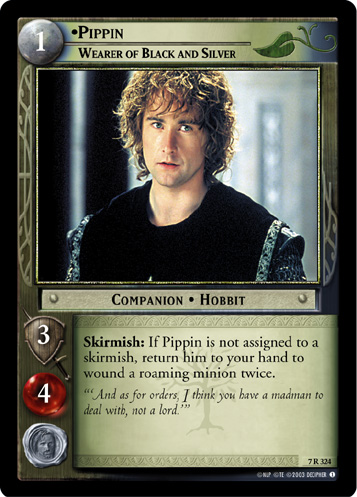 , who shake off all stacked cards
, who shake off all stacked cards - Relatively worse than most other Shadow cards most of the time outside of Fellowship block due to its situational nature







